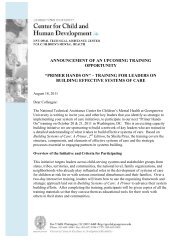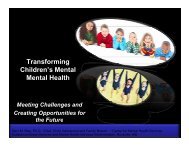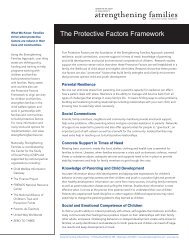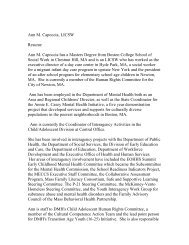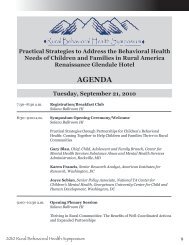Training Institutes 2012 - National Technical Assistance Center for ...
Training Institutes 2012 - National Technical Assistance Center for ...
Training Institutes 2012 - National Technical Assistance Center for ...
Create successful ePaper yourself
Turn your PDF publications into a flip-book with our unique Google optimized e-Paper software.
INSTITUTES<br />
• Cultural accommodations (rather than adaptations) to the evidence-based practice being implemented<br />
• Low-burden, low-cost evaluation as a sustainability strategy<br />
The participants will be encouraged to participate in implementation planning exercises in order to see how the model<br />
might apply to their organizations. The faculty team will offer the perspectives of a statewide coordinator <strong>for</strong> the<br />
implementation of Functional Family Therapy model who also represents a family perspective and an evaluator <strong>for</strong><br />
evidence-based practice implementation who provides the perspective of implementing and sustaining program<br />
per<strong>for</strong>mance and outcome evaluation activities.<br />
MODERATOR/PRESENTER: Lynne Marsenich, M.S.W., Senior Associate, Cali<strong>for</strong>nia Institute <strong>for</strong> Mental Health,<br />
Sacramento, CA<br />
Pam Hawkins, Senior Associate, <strong>Center</strong> <strong>for</strong> Practice Improvement and Innovation, Cali<strong>for</strong>nia Institute <strong>for</strong> Mental<br />
Health, Sacramento, CA<br />
Tracye Jones, Behavioral Health Administrator, Administration, Shields <strong>for</strong> Families, Los Angeles, CA<br />
Cricket Mitchell, Ph.D., Senior Associate, Cali<strong>for</strong>nia Institute <strong>for</strong> Mental Health, Sacramento, CA<br />
INSTITUTE #6 1:30 PM THURSDAY • 8:30 AM SATURDAY • OSCEOLA 1-2<br />
Youth Suicide Prevention: Implementing Evidence-Based<br />
and Effective Approaches in Communities<br />
OBJECTIVES—Participants will learn:<br />
1. To describe the key components of a youth suicide prevention framework<br />
2. How to use strategies <strong>for</strong> mobilizing community members to help address youth suicide and related issues<br />
3. To employ methods <strong>for</strong> organizing suicide prevention awareness activities<br />
4. To identify concrete steps <strong>for</strong> adopting a suicide prevention resource <strong>for</strong> community and school use<br />
This Institute will focus on evidence-in<strong>for</strong>med interventions and tools that can be implemented in communities and<br />
schools to address issues related to youth suicide prevention. The strategies and tools to be highlighted include using<br />
suicide prevention awareness tools, gatekeeper training, Mental Health First Aid training, and The Youth Suicide<br />
Prevention School-Based Guide that is available online.<br />
The strategies to be highlighted will be based on the suicide prevention work of faculty members at local, state, and<br />
national levels. To illustrate a community’s approaches to youth suicide prevention, two communities will highlight their<br />
strategies, tools, and experiences. A system of care in northeast Iowa (Community Circle of Care) will share their<br />
community-based, multi-pronged approach to suicide prevention. A community in Orange County, New York, created an<br />
Orange County Suicide Prevention Committee that promotes awareness of suicide and provides the community with<br />
prevention and education activities and customized the Youth Suicide Prevention School-Based Guide as part of their<br />
overall youth suicide prevention strategy.<br />
Specific topics to be covered include:<br />
• Key components of a youth suicide prevention framework with applications <strong>for</strong> communities, schools, and agencies<br />
through a research-in<strong>for</strong>med resource with useful assessment checklists that are included in the Suicide Prevention<br />
Resource <strong>Center</strong>’s Best Practices Registry<br />
• In<strong>for</strong>mation on how to coordinate a Suicide Awareness and Prevention walk and ideas on how to solicit donations <strong>for</strong><br />
sustainability of this type of suicide prevention awareness activity<br />
• Suicide prevention awareness activity strategies include presenting gatekeeper training programs, mental health<br />
presentations, and suicide prevention education training that educate participants about the signs and symptoms of<br />
depression and suicide risk as well as how to help a friend/yourself<br />
• Mental Health First Aid training that includes suicide prevention in<strong>for</strong>mation, with an example from a community that<br />
has trained over 750 professionals, parents, youth, and general community members, including implementation<br />
strategies, ideas <strong>for</strong> overcoming barriers, and success stories<br />
• Different pragmatic methods <strong>for</strong> adopting a research-in<strong>for</strong>med suicide prevention resource (the Youth Suicide<br />
Prevention School-Based Guide) through sharing implementation strategies, ideas <strong>for</strong> overcoming barriers, success<br />
stories, and how this resource might fit into an overall youth suicide prevention ef<strong>for</strong>t<br />
38 <strong>Training</strong> <strong>Institutes</strong> <strong>2012</strong>



